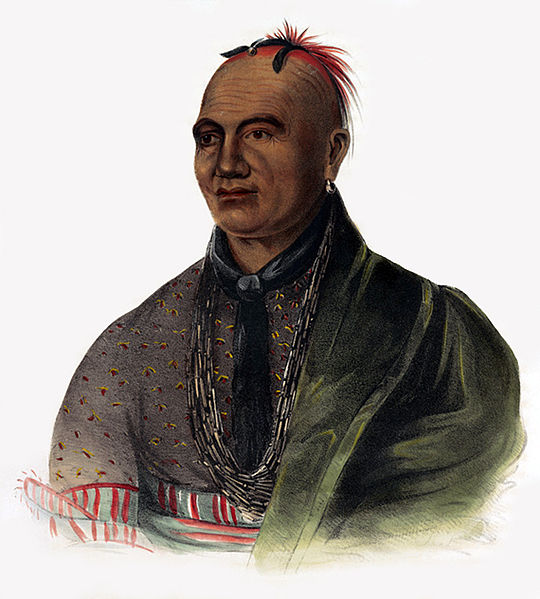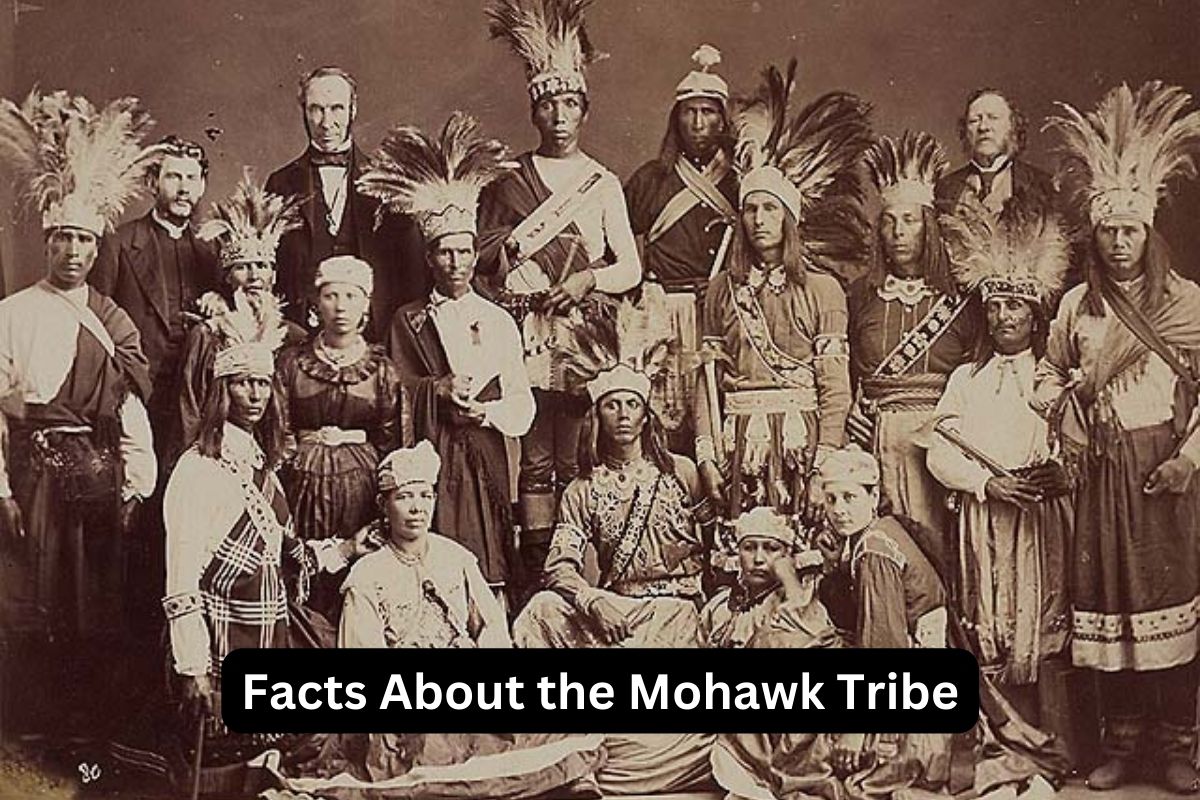The Mohawk Tribe, also known as the Kanienʼkehá꞉ka, is one of the six Native American nations forming the Iroquois Confederacy. They inhabited the northeastern region of North America, primarily in upstate New York.
The Mohawk Tribe is recognized for their agricultural prowess, particularly their cultivation of the “Three Sisters” crops:
- Corn
- Beans
- Squash
They were known for their skilled warriors and their distinctive hairstyle, the “Mohawk.” The Mohawk Tribe follows a matrilineal kinship system, and women played important roles in decision-making processes. They have a rich cultural heritage, with ceremonies and festivals that celebrate their traditions.
The Mohawk Tribe has faced historical challenges, and today they work to preserve their language, traditions, and cultural practices while addressing issues of land rights and sovereignty.
Mohawk Tribe Facts
1. The Mohawk Tribe, also known as the Kanienʼkehá꞉ka, is one of the six Native American nations forming the Iroquois Confederacy
The Mohawk Tribe, also known as the Kanienʼkehá꞉ka, is one of the six Native American nations forming the Iroquois Confederacy, or Haudenosaunee which also includes:
- Onondaga
- Oneida
- Cayuga
- Seneca
- Tuscarora
The Iroquois Confederacy is one of the oldest known participatory democracies in the world, with a constitution called the Great Law of Peace that guides their governance. The Confederacy was established to promote peace, unity, and cooperation among the member tribes.

2. The Mohawk people originally inhabited the northeastern region of North America
The traditional territory of the Mohawk Tribe extended across what is now upstate New York, covering parts of the Mohawk River Valley and the Adirondack Mountains.
Also Read: Facts About the Blackfoot Tribe
Their homeland encompassed both fertile river valleys for agriculture and dense forests for hunting and gathering. The Mohawk people relied on the natural resources of the region for sustenance and trade.
3. The Mohawk Tribe is recognized for their skill in agriculture, particularly the cultivation of corn, beans, and squash
The Mohawk Tribe excelled in agriculture and developed sophisticated farming techniques. They cultivated the “Three Sisters” crops, which included corn, beans, and squash.
This agricultural system, known as companion planting, was highly sustainable and beneficial for all three crops. Corn provided a support structure for the beans to climb, while the beans added nitrogen to the soil, benefiting the corn and squash.
Also Read: Navajo Tribe Facts
The squash acted as a natural ground cover, suppressing weed growth and conserving soil moisture. The Three Sisters formed the foundation of the Mohawk diet and provided a balanced nutritional source.
The Mohawk Tribe’s agricultural practices also extended to other crops, such as tobacco, sunflowers, and various medicinal plants.
They understood the importance of maintaining a harmonious relationship with the land and practiced sustainable farming techniques that allowed for long-term food security while respecting the environment.
The knowledge of these agricultural practices was passed down through generations and remains an important part of Mohawk cultural heritage.
4. Historically, the Mohawk Tribe was known for their fierce and strategic warriors
The Mohawk Tribe had a reputation for being fierce and skilled warriors. They were renowned for their strategic abilities in warfare and often served as scouts and fighters for the other nations of the Iroquois Confederacy.
Mohawk warriors were highly disciplined, using tactics such as ambushes, hit-and-run attacks, and coordinated assaults. They were skilled in using various weapons, including bows and arrows, tomahawks, and war clubs.
The Mohawk Tribe’s warrior tradition played a significant role in defending their lands, protecting their people, and engaging in conflicts with both European settlers and other Native American tribes.
5. The Mohawk people are well-known for their distinctive hairstyle
The Mohawk Tribe is widely recognized for their distinctive hairstyle, commonly known as a “Mohawk” or “Mohawk haircut.” This traditional hairstyle involves shaving or closely cropping the hair on the sides of the head while leaving a strip of longer hair down the middle.
The hair on the strip is often styled upright, creating a crest-like appearance. Mohawk men historically wore this hairstyle as a symbol of courage, strength, and tribal identity.
Today, the Mohawk hairstyle has become a cultural symbol for Indigenous resistance, self-expression, and pride, embraced by individuals from various backgrounds.
6. The Mohawk Tribe has a matrilineal kinship system, meaning that descent and inheritance are traced through the female line
The Mohawk Tribe follows a matrilineal kinship system, where lineage and family ties are traced through the female line. In Mohawk society, clan membership is determined by the mother’s clan, and children belong to their mother’s clan.
This matrilineal system also extends to inheritance and property rights, where land and resources are typically passed down through the female line. Women in Mohawk society held positions of influence and played important roles in decision-making processes, including selecting leaders and participating in governance.
This emphasis on female lineage and women’s roles highlights the significance and respect given to women within Mohawk culture. Additionally, women played important roles in agriculture, nurturing the Three Sisters crops and ensuring the community’s food security.
7. The Mohawk Tribe has a rich cultural heritage and traditional practices that have been passed down through generations
The Mohawk Tribe has a rich cultural heritage and continues to maintain and celebrate their traditional practices. They have various ceremonies, dances, and rituals that are integral to their cultural identity.
One of the significant ceremonies is the Strawberry Festival, which marks the beginning of the strawberry harvest. It is a time of celebration, gratitude, and renewal. The Green Corn Festival is another important event, held to give thanks for the corn harvest and to ensure the well-being of the community.
These ceremonies and festivals provide opportunities for community members to come together, honor their traditions, share stories, and pass on cultural knowledge to younger generations.
8. The Mohawk people have faced significant challenges and conflicts throughout history
Throughout their history, the Mohawk people have faced numerous challenges and conflicts. Like other Native American tribes, they experienced conflicts with European settlers during the colonial period. They also engaged in territorial disputes with other Indigenous nations.
These conflicts were often driven by competition over resources and land. Today, the Mohawk Tribe continues to address issues related to land rights and sovereignty. They strive to protect their ancestral lands, maintain their cultural practices, and navigate modern challenges while preserving their cultural heritage.
9. The Mohawk Tribe has been involved in the construction and maintenance of major infrastructure projects
Mohawk ironworkers have made significant contributions to the construction industry, particularly in the field of high-rise buildings and bridges. The Mohawk Tribe has a long-standing tradition of ironworking, and their skilled workers have been sought after for their expertise, fearlessness, and craftsmanship.
Mohawk ironworkers have worked on iconic structures such as the Empire State Building, the World Trade Center, and the Hoover Dam.
Their involvement in these construction projects has not only provided economic opportunities for the community but has also brought recognition to the Mohawk Tribe’s contributions to the development of modern infrastructure.
10. The Mohawk Tribe maintains a strong sense of community and has worked to preserve and revitalize their language, traditions, and cultural practices
The Mohawk Tribe places a strong emphasis on community and cultural preservation. Efforts are made to revitalize and preserve the Mohawk language, which is part of the Iroquoian language family.
Language immersion programs, language classes, and cultural education initiatives have been established to ensure the transmission of the Mohawk language and cultural practices to younger generations. The tribe also operates cultural centers and museums that serve as repositories of Mohawk history, artifacts, and traditional knowledge.
These institutions provide educational resources and opportunities for community members and visitors to learn about Mohawk culture, fostering a sense of pride and connection to their heritage.
